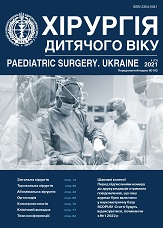Analysis of mathematical modeling of a biomechanical model of halo-graviеn traction in spinal deformities in children
DOI:
https://doi.org/10.15574/PS.2021.73.66Keywords:
final element method, spinal deformity, halo-gravity tractionAbstract
Halo-gravity traction (HGT) systems are widely used in leading clinics around the world as a staged method for correcting complex (>100°) scoliotic deformities of the spine in children. Today there is no single approach to the use of this technique, and each doctor makes a decision regarding the treatment regimen empirically, based on his clinical experience.
Purpose – to investigate with the help of finite element method the stress-strain state of the spine of various degrees of deformation using HGT.
Materials and methods. When constructing the computational model, geometric models of various parts of the spine, developed in the laboratory of biomechanics of the State Institution «IPPS named after I.P. Sitenko of the National Academy of Medical Sciences of Ukraine». The following changes were made to the model, in accordance with the purpose of the study: spinal deformity 70° and 100°; added skull model; added model of HGT and its fixation to the skull.
Results. When using the HGT system with fixation, the most loaded part of the spine is the T2-T5 vertebrae. It should be noted that with an increase in the degree of deformity, the T4 and T5 vertebrae become loaded. The HGT system with fixation and load equal to half the body weight does not lead to critical values of bone tissue stress in terms of strength.
Results. In the treatment of rigid spinal deformities in children with a deformity angle (>100°) using a HGT system, the first stage mathematically proved the effectiveness of this technique, but the maximum recommended load should not exceed 50% of the patient’s body weight. Modeling the correction of spinal deformities using mathematical models makes it possible to analyze the effect of various treatment methods in several versions without surgery. The maximum von Mises stress value of 40.1 MPa is not critical for bone tissue in terms of strength (ultimate strength for cortical bone is 70 MPa). However, when the load is doubled, i.e. with HGT to a load equal to the body weight, the level of stress will also double and exceed the ultimate strength of the bone tissue.
The research was carried out in accordance with the principles of the Helsinki declaration. The study protocol was approved by the Local ethics committee of all participating institutions. The informed consent of the patient was obtained for conducting the studies.
No conflict of interest was declared by the authors.
References
Fialho J. (2018). A biomechanical model for the idiopathic scoliosis using robotic traction devices// International Conference on Mathematical Modelling in Physical Sciences IOP Conf. Series: Journal of Physics: Conf. 1141: 012022. https://doi.org/10.1088/1742-6596/1141/1/012022
Ghista DN, Viviani GR, Subbaraj K et al. (1988). Biomechanical basis of optimal scoliosis surgical-correction. J Biomech. 21 (2): 77-88. https://doi.org/10.1016/0021-9290(88)90001-2
Kimsal J, Khraishi T. (2009). Experimental investigation of halogravity traction for paediatric spinal deformity correction. Int J Experimental and Computational Biomechanics. 1 (2): 204-213. https://doi.org/10.1504/IJECB.2009.029197
Kong WZ, Goel VK. (2003). Ability of the Finite Element Models to Predict Response of the Human Spine to Sinusoidal Vertical Vibration/SPINE. 28 (17): 1961-1967. https://doi.org/10.1097/01.BRS.0000083236.33361.C5; PMid:12973142
Kurowski PM. (2012, Apr 11). Engineering Analysis with Solid-Works Simulation 2012: 475. ISBN: 978-1-58503-710-0.
Lafage V, Dubousset J, Lavaste F, Skalli W. (2002). Finite element simulation of various strategies for CD correction. Stud Health Technol Inform. 91: 428-432.
Lafon Y, Steib JP, Skalli W. (2010). Intraoperative three dimensional correction during in situ contouring surgery by using a numerical model. Spine (Phila Pa 1976). 35: 453-459. https://doi.org/10.1097/BRS.0b013e3181b8eaca; PMid:20110840
Lalonde NM, Villemure I, Pannetier R et al. (2010). Biomechanical modeling of the lateral decubitus posture during corrective scoliosis surgery// Clin Biomech. 25: 510-516. https://doi.org/10.1016/j.clinbiomech.2010.03.009; PMid:20413197
Little JP, Izatt MT, Labrom RD, Askin GN, Adam CJ. (2013, May 16). An FE investigation simulating intra-operative corrective forces applied to correct scoliosis deformity. Scoliosis. 8 (1): 9. https://doi.org/10.1186/1748-7161-8-9; PMid:23680391 PMCid:PMC3680303
Salmingo R, Tadano S, Fujisaki K et al. (2012). Corrective force analysis for scoliosis from implant rod deformation. Clin Biomech (Bristol, Avon). 27: 545-550. https://doi.org/10.1016/j.clinbiomech.2012.01.004; PMid:22321374
Semmelink K, Hekman EEG, van Griethuysen M, Bosma J, Swaan A, Kruyt MC. (2021, Jan). Halo pin positioning in the temporal bone; parameters for safe halo gravity traction. Spine Deform. 9 (1): 255-261. https://doi.org/10.1007/s43390-020-00194-2; PMid:32915397
Vidal-Lesso A, Ledesma-Orozco E, Daza-Benitez L, Lesso-Arroyo R. (2014). Mechanical Characterization of Femoral Cartilage Under Unicompartimental Osteoarthritis. Ingenieria mecanica tecnologia y desarrollo. 4 (6): 239-246.
Voor MJ, Anderson RC, Hart RT. (1997, Sep). Stress analysis of halo pin insertion by non-linear finite element modeling. J Biomech. 30 (9): 903-909. https://doi.org/10.1016/S0021-9290(97)82887-4
Wang Y, Li C, Liu L, Li H, Yi X. (2021). Presurgical Short-Term Halo-Pelvic Traction for Severe Rigid Scoliosis (Cobb Angle >120): A 2-Year Follow-up Review of 62 Patients. Spine (Phila Pa 1976). 46 (2): E95-E104. https://doi.org/10.1097/BRS.0000000000003740; PMid:33038196
Zienkiewicz OC, Taylor RL. (2005). The Finite Element Method for Solid and Structural Mechanics. Sixth edition. Butterworth-Heinemann: 736.
Downloads
Published
Issue
Section
License
The policy of the Journal “PAEDIATRIC SURGERY. UKRAINE” is compatible with the vast majority of funders' of open access and self-archiving policies. The journal provides immediate open access route being convinced that everyone – not only scientists - can benefit from research results, and publishes articles exclusively under open access distribution, with a Creative Commons Attribution-Noncommercial 4.0 international license(СС BY-NC).
Authors transfer the copyright to the Journal “PAEDIATRIC SURGERY.UKRAINE” when the manuscript is accepted for publication. Authors declare that this manuscript has not been published nor is under simultaneous consideration for publication elsewhere. After publication, the articles become freely available on-line to the public.
Readers have the right to use, distribute, and reproduce articles in any medium, provided the articles and the journal are properly cited.
The use of published materials for commercial purposes is strongly prohibited.

